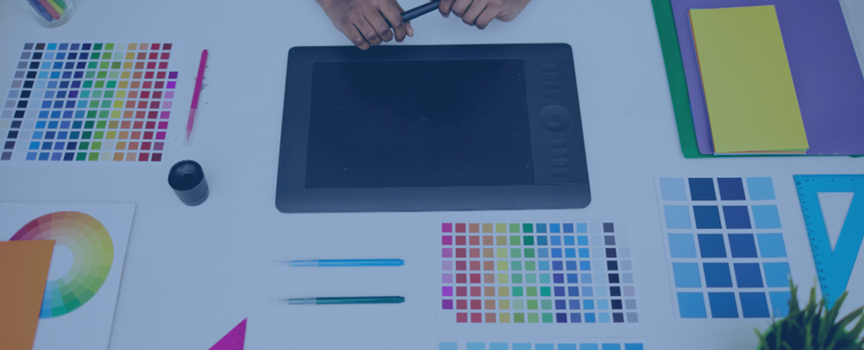Designing for Print vs. Digital: Key Differences

Table of Contents
Graphic design is at the heart of modern marketing, yet not all designs are created on the same principles. With the rapid evolution of technology, print vs digital design has become a significant consideration for graphic designers, brands, and marketing professionals. Understanding the differences can be the key to exploring a business branding guide that appeals to your target market.
If you’re a graphic designer, brand owner, or marketing professional, you’ve likely dealt with whether to design for print or digital media. Each medium comes with its own set of rules and challenges. According to a study by Adobe, 76% of marketers believe that the use of digital media will continue to grow in importance. Yet, traditional print media still holds a solid place, with 56% of consumers finding printed materials the most trustworthy form of marketing.
This blog post explores the distinctions between print and digital design, offering insights, practical tips, and examples to guide you through your next project.
Key Differences in Design Considerations

Visual Elements
Print vs digital design starts with understanding visual elements like colour, resolution, and format. In print design, colours are often rendered using CMYK (Cyan, Magenta, Yellow, and Key), while digital designs use RGB (Red, Green, and Blue). This difference can dramatically impact how colours appear in the final product.
- Colour: Print uses CMYK for accuracy, while digital uses RGB for vibrancy.
- Resolution: Print requires a higher resolution (300 DPI) than digital (72 DPI).
- Format: Print formats are fixed, whereas digital formats can adapt to different screen sizes.
Typography
Typography in print vs digital design is another crucial factor. What might look good on paper may translate poorly on a screen. For example, serif fonts are often easier to read in print, while sans-serif fonts are preferred for digital content due to their clarity on screens.
- Font Choice: Serif fonts for print, sans-serif for digital.
- Size: Print allows for detailed typography, while digital needs larger text for readability.
- Readability: Spacing and line height differ significantly between the two mediums.
Layout and Spacing
Layout and spacing in print vs digital design require different approaches. Print layouts are static and designed to be viewed at a fixed size. On the other hand, digital layouts need to be flexible and responsive to various device screens.
- Static vs Responsive: Print is static; digital is fluid.
- Margins and Padding: Print often has more generous margins, while digital design uses padding to create breathing space.
- Grid Systems: Print layouts rely on strict grid systems, while digital can be more flexible.
Also Read:
- The Role of Graphic Design in Building Brand Identity
- Best Practices For Designing Social Media Graphics
- Top 5 Website Maintenance Tips for Hospitality Websites
- How Local SEO Can Drive More Customers to Your Business
- Transform Your Lead Generation with Powerful CTAs
Design Tools and Software

Designers have a plethora of tools tailored for each medium. Adobe InDesign and Illustrator are staples for print design, while tools like Sketch and Figma are popular for digital designs. These tools offer features that cater to the specific needs of each medium. Whether you hire a professional designer or use tools, ensure that designs should be high-quality and reflect your brand’s identity.
Check out design tools for printing and design tools for digital designs.
- Adobe InDesign: Ideal for detailed print layouts.
- Sketch/Figma: Perfect for interactive and responsive digital designs.
- Photoshop: Versatile for both print and digital but often used for image editing.
Graphic Design Best Practices for Print and Digital
To excel in print vs digital design, following best practices can ensure your work stands out.
Print Design Best Practices
- Use high-resolution images to avoid pixelation.
- Ensure colour accuracy with proper CMYK profiles.
- Choose fonts that are legible in print and consider the material’s texture.
Digital Design Best Practices
- Optimise images for faster load times without sacrificing quality.
- Use responsive design techniques for different screen sizes.
- Test your design across various devices and browsers for consistency.
All the above-mentioned practices also help improve SEO rankings.
Case Studies
Successful Print Design
The New York Times’ rebranding in 2016 is a stellar example of print design excellence. The redesign focused on typography and layout, maintaining the paper’s classic look while updating it for modern readers.
Successful Digital Design
Spotify’s Wrapped campaign is a fantastic example of digital design. Its vibrant colours, dynamic layouts, and interactive elements made it a hit across various devices and platforms.
Final Words!
Understanding print and digital design is crucial for any graphic designer, brand, or marketing professional. Each medium has unique challenges and advantages; knowing how to leverage these can make your designs more effective and engaging. Remember, your choice of medium should align with your brand’s goals and your audience’s preferences.
Whether you’re working on a print project or a digital campaign, keeping these considerations in mind will help you create compelling and effective designs.
